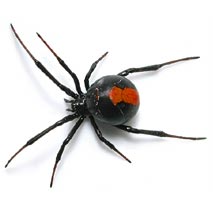
Red-back Spider
Latrodectus hasseltii
Family: Theridiidae ID: Thorell, 1870

Habitat and Biology
This spider is commonly found outdoors around human habitation, in such places
as rubbish, litter, old tins, containers, under and on steps of the verandah,
and on or under the seats of outdoor toilets! Storage stacks and disused furniture
will encourage the breeding of this spider. In nature, it occurs under logs,
bark, sides of rocks, etc. As the spider rarely leaves its web, humans are not
likely to be bitten unless some part of the body (eg. the hand) is put into
the web. Always check before moving items that have been stored outdoors for
some time. Wear gloves when cleaning up rubbish areas. The female produces up
to ten pale-yellow egg sacs, each with approximately 250 eggs. Females may live
for two to three years, males about 90 days.
Colour
Male: Usually without red markings. Body light brown with white markings on
upperside of abdomen, and pale hour-glass marking on underside.
Female: Body and legs dark brown to black. Characteristic red hour-glass marking
on underside of abdomen, usually also with broad, red stripe on upperside of
rear half of abdomen; red stripe sometimes broken. Juveniles recognised by white
markings on abdomen.
Form
Characteristic pea-shaped abdomen, long slender legs, males much smaller than
females. For more information, see the Queensland Museum Spider
Page.
Body Length
Male: 4mm
Female: 10mm
Web type
Tangled web with sticky catching attached to substrate.
Bite
The bite is highly
venomous and characterised by intense localised pain at and around the bite
site. Other symptoms may include sweating, muscular weakness, loss of co-ordination
and, in severe cases nausea, vomiting, convulsions, etc. The following envenomation
description is from The Australian Animal Toxins by Struan Sutherland,
1983. Signs and Symptoms: The normal sequence of events after a bite is as follows.
A sharp pin-pricking pain is almost invariable. Usually the bite site becomes
hot, erythema and oedema develop rapidly. Localized sweating often occurs. The
swelling is generally limited to an area of several cm in radius from the bite
site; occasionally it is extreme. Approximately five minutes after the bite,
intense local pain commences and increases in severity and distribution. In
most cases, pain is the predominant symptom; the patient is sometimes distraught
and even hysterical because of its intensity. Movement of the affected limb
often significantly increases the pain. About thirty minutes after the bite,
pain and swelling are often experienced in the regional lymph nodes. If abdominal
pain occurs, it is worse when the lower extremities or genitals were bitten,
probably due to lymph node involvement. Sometimes severe pain develops in parts
remote from the bite site, for example, in an opposite limb or the opposite
side of the trunk. Uncommon, even bizarre, signs and symptoms developed in some
cases. There were tetanic spasms, tingling in the teeth, swelling of the tongue,
bite site infection, convulsions, excessive thirst, severe diarrhoea, anaphylactic
reaction to the venom, blotchy rash on face, haemoptysis, dyspnoea, dysuria,
severe trismus, persistent anorexia, periorbital oedema and/or conjunctivas.
Patchy areas of what was described as `bizarre sweating' were not uncommon.
For additional information see http://www.usyd.edu.au/su/anaes/spiders.html